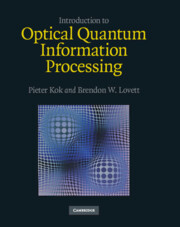Book contents
- Frontmatter
- Dedication
- Contents
- Preface
- Part I Quantum optics and quantum information
- 1 The quantum theory of light
- 2 Quantum information processing
- 3 Figures of merit
- Part II Quantum information in photons and atoms
- Part III Quantum information in many-body systems
- Appendix A Baker–Campbell–Haussdorff relations
- Appendix B The Knill–Laflamme–Milburn protocol
- Appendix C Cross–Kerr nonlinearities for single photons
- References
- Index
1 - The quantum theory of light
from Part I - Quantum optics and quantum information
Published online by Cambridge University Press: 05 July 2014
- Frontmatter
- Dedication
- Contents
- Preface
- Part I Quantum optics and quantum information
- 1 The quantum theory of light
- 2 Quantum information processing
- 3 Figures of merit
- Part II Quantum information in photons and atoms
- Part III Quantum information in many-body systems
- Appendix A Baker–Campbell–Haussdorff relations
- Appendix B The Knill–Laflamme–Milburn protocol
- Appendix C Cross–Kerr nonlinearities for single photons
- References
- Index
Summary
Classically, light is an electromagnetic phenomenon, described by Maxwell's equations. However, under certain conditions, such as low intensity or in the presence of certain nonlinear optical materials, light starts to behave differently, and we have to construct a ‘quantum theory of light’. We can exploit this quantum behaviour of light for quantum information processing, which is the subject of this book. In this chapter, we develop the quantum theory of the free electromagnetic quantum field. This means that we do not yet consider the interaction between light and matter; we postpone that to Chapter 7. We start from first principles, using the canonical quantization procedure in the Coulomb gauge: we derive the field equations of motion from the classical Lagrangian density for the vector potential, and promote the field and its canonical momentum to operators and impose the canonical commutation relations. This will lead to the well-known creation and annihilation operators, and ultimately to the concept of the photon. After quantization of the free electromagnetic field we consider transformations of the mode functions of the field. We will demonstrate the intimate relation between these linear mode transformations and the effect of beam splitters, phase shifters, and polarization rotations, and show how they naturally give rise to the concept of squeezing. Finally, we introduce coherent and squeezed states.
Information
- Type
- Chapter
- Information
- Publisher: Cambridge University PressPrint publication year: 2010
